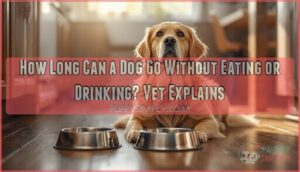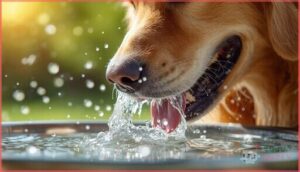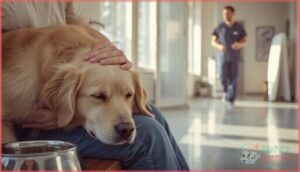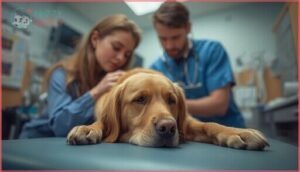This site is supported by our readers. We may earn a commission, at no cost to you, if you purchase through links.
Your dog skips breakfast, then ignores dinner. By the next morning, their water bowl sits untouched. As a veterinarian, I know that moment when concern turns to alarm—and for good reason.
While dogs can survive three to five days without food, dehydration becomes life-threatening much faster, often within 24 to 48 hours. The gap between “picky eater” and “medical emergency” is narrower than most pet owners realize.
Understanding how long a dog can go without eating or drinking—and recognizing the warning signs along the way—can mean the difference between a minor health hiccup and a crisis that demands immediate intervention.
Table Of Contents
- Key Takeaways
- Dog Survival Basics
- How Long Without Eating
- Water Importance
- Factors Influencing Survival
- Causes of Loss Appetite
- Seeking Veterinary Care
- Encouraging Eating Habits
- When to Contact Vet
- Frequently Asked Questions (FAQs)
- What happens if a dog doesn’t eat or drink for 2 days?
- How long can a dog go without eating or drinking?
- How long can a dog go without food and water?
- How long can a dog survive without food?
- Can a dog go a day without eating?
- How long can a dog survive without water?
- Can a dog go without water?
- How long can a dog go without eating?
- How long can a dog live if he doesn’t eat?
- How long can a dog go without water?
- Conclusion
Key Takeaways
- While dogs can survive three to five days without food, dehydration becomes life-threatening much faster—often within 24 to 48 hours—making water access far more critical than food in the short term.
- Puppies, senior dogs, and those with pre-existing health conditions like diabetes or kidney disease can deteriorate within just 12 to 24 hours without food or water, significantly shorter than healthy adult dogs.
- Warning signs requiring immediate veterinary attention include dry or tacky gums, sunken eyes, slow skin recoil, lethargy, persistent vomiting, and any refusal of food or water lasting more than 24 hours.
- Loss of appetite stems from multiple causes including medical conditions (kidney disease, cancer, dental pain), behavioral issues (stress, anxiety, routine changes), and gastrointestinal problems—all requiring veterinary evaluation to prevent organ damage.
Dog Survival Basics
Your dog’s body needs food and water to function, but understanding how long they can go without either helps you recognize when something’s wrong.
When dogs miss meals or stop drinking, their bodies start breaking down quickly, and the effects can be serious.
Let’s look at what happens when your dog goes without these essentials and why timing matters so much.
Importance of Food and Water
Your dog’s survival hinges on food and water working together to keep everything running. Food delivers nutrients your dog needs for energy requirements and organ function, while water drives nutrient absorption, circulation, and temperature control through hydration effects. Without either one, dog health deteriorates fast—dehydration sets in, weakness follows, and vitality plummets. Recognizing signs of dehydration is key for timely intervention.
To protect your companion, make sure you provide:
- Fresh water available throughout the day
- Complete, balanced meals suited to their needs
- Regular vet visits to catch problems early
Effects of Prolonged Fasting
After missing meals, your dog’s body quickly shifts gears. First, it draws on stored sugars, but soon Metabolic Adaptation takes over, relying on fat for fuel. As days pass, Protein Catabolism sets in—muscle breaks down to keep essential organs going.
This can leave your dog weaker, less playful, and more vulnerable to illness as Immune Changes begin. The Gut Microbiome also shifts, sometimes causing stomach upset or bile vomiting.
If you suddenly offer a big meal after prolonged fasting, Refeeding Risks like dangerous electrolyte shifts can threaten recovery. These dog starvation effects are serious health concerns.
Some owners explore intermittent fasting routines for potential health benefits.
Risks of Dehydration
Soon after food runs low, lack of water becomes the bigger threat. Thick saliva, sunken eyes, and poor skin elasticity warn of dog dehydration.
Without quick action, organ damage and electrolyte imbalance set in, raising heatstroke risks and possible circulatory failure. Kidney injury can follow fast.
Watching for dehydration signs helps protect your dog’s health and hydration every day.
How Long Without Eating
Skipping meals isn’t just a matter of hunger—it’s a test of your dog’s resilience. For healthy adults, the Fasting Duration usually tops out at 3–5 days before Organ Damage risk jumps. Puppy Vulnerability means young dogs can’t go nearly as long; even missing one meal can trigger serious Metabolic Stress. Anorexia Thresholds for seniors and sick pets are lower, often just 24–48 hours. Wondering how long can dogs go without food? Watch for these signs in a dog not eating:
- Lethargy and weakness
- Noticeable weight loss
- Loss of interest in food
- Muscle wasting
- General distress or discomfort
If you spot these, dog appetite loss could signal bigger dog health concerns. Don’t wait—contact your vet quickly.
Water Importance
Water is your dog’s lifeline. While they can survive several days without food, dehydration becomes dangerous much faster.
Let’s look at how to recognize the warning signs, keep your dog properly hydrated, and monitor their water intake effectively.
Dehydration Signs and Symptoms
Your dog’s body sends clear warning signs of dehydration that you shouldn’t ignore. Check their gums—dry or tacky membranes signal trouble. Gently pinch their skin; slow recoil means poor skin turgor. Watch for sunken eyes, lethargy, and weak pulse quality. At 5-8% dehydration, these canine dehydration symptoms demand action.
| Dehydration Level | Warning Signs of Dehydration |
|---|---|
| Mild (5%) | Tacky gum moisture, slight lethargy |
| Moderate (6-8%) | Slow skin turgor, sunken eyes, prolonged pulse |
| Severe (10%+) | Collapse, organ failure risk |
Immediate dog dehydration treatment prevents life-threatening complications.
Encouraging Water Intake
When hydration drops, a few simple tricks can turn reluctant drinkers into enthusiastic lappers. Flavored water—like low-sodium chicken or beef broth—appeals to many dogs’ taste buds, especially seniors or picky sippers. Moisture-rich diets from canned or fresh foods naturally boost total water intake, helping dogs who won’t drink enough plain water.
Water presentation matters: try pet fountains with circulating flow, multiple bowls around your home, or cool (not ice-cold) refills several times daily. Enrichment approaches like floating ice cubes or offering drinking water right after a walk tap into natural thirst peaks.
For dogs recovering from illness, clinical strategies such as veterinary oral recuperation fluids can support both hydration and appetite.
Monitoring Hydration Levels
Beyond the basics, clinical assessment of hydration levels relies on multiple markers. Test skin turgor at your dog’s back—healthy skin snaps back immediately, while dehydration symptoms include slow return or persistent tenting. Check for tacky gums and dark, concentrated urine.
Intake benchmarks suggest roughly 50–100 milliliters per kilogram daily. Digital trackers can log consumption trends, helping you spot subtle declines before dehydration becomes an emergency.
Factors Influencing Survival
Not every dog can survive the same amount of time without food or water. Several key factors determine how long your pet can endure these conditions before serious health problems develop.
Let’s look at the main influences that affect your dog’s ability to withstand periods without proper nutrition and hydration.
Age and Vulnerability
Your dog’s age dramatically shifts survival timelines. Healthy adults generally last three to five days without food when water is available, but puppies and senior dogs may decompensate within 12 to 24 hours due to limited energy reserves.
Each kilogram of excess weight in older dogs raises mortality risk by 19%, while age-related comorbidities like kidney disease shorten safe fasting windows even further.
Access to Water
Access to clean drinking water dramatically extends your dog’s survival window. When water is available, healthy adults can withstand three to five days without food, but without water, critical dehydration often develops within 72 hours.
Environmental factors accelerate this timeline—hot weather and high activity levels can trigger dangerous fluid loss in under 24 hours, making consistent hydration essential for your dog’s safety.
Health Status
Pre-existing medical conditions can shorten your dog’s safe fasting window dramatically. Dogs with diabetes or kidney disease may deteriorate after missing just one day of meals, while healthy adults usually manage three to five days. Here’s what matters most:
- Chronic Illnesses: Organ dysfunction limits your dog’s ability to handle metabolic stress during fasting
- Immune System: Weakened immunity increases vulnerability to dehydration and underlying health issues
- Medication Effects: Some prescriptions require food intake to prevent dangerous side effects
- Genetic Predisposition: Certain breeds face higher health risks when nutritional intake drops
Causes of Loss Appetite
When your dog turns up their nose at dinner, it’s not always a simple case of being picky. Loss of appetite can signal anything from a minor upset to a serious health concern that needs immediate attention.
Let’s look at the most common reasons why dogs stop eating so you can better understand what might be happening with your furry friend.
Medical Conditions
When your dog refuses food, kidney disease, liver dysfunction, or cancer effects may be the culprit. In one study, anorexia appeared in 84% of dogs with acute kidney problems, making it the most common sign. Systemic illness affecting organs can trigger appetite loss quickly.
Watch for vomiting, unusual lumps suggesting cancer, or lethargy pointing to diabetes. Dental disease and painful mouth conditions also rank high as medical causes.
If your dog shows rapid weight loss or signs of organ failure, veterinary recommendations emphasize prompt evaluation—underlying health issues require immediate attention.
Behavioral Issues
While medical conditions affect appetite, your dog’s emotional state plays an equally important role. Stress-induced loss appears in nearly 13% of dogs with separation issues, and noise sensitivity triggers reduced food intake in 32% of cases. Routine disruption—like changing feeding times or moving homes—can cause your dog to stop eating entirely.
Food neophobia makes dogs hesitant around new diets, showing increased distraction on day one. Anxiety comorbidities compound the problem, as aggressive dogs are 3.2 times more likely to refuse food due to fear-related behavior.
Dental Issues and Oral Health
When your dog refuses to eat or drink, don’t overlook dental pain. Periodontal disease affects up to 80% of dogs over age 3, causing oral discomfort that makes chewing difficult. Tooth resorption, fractured teeth, and stomatitis create painful conditions that discourage normal food intake. You might notice:
- Bad breath signaling gum inflammation
- Chewing on one side only
- Dropping food while eating
- Visible tartar buildup
- Reluctance to touch hard kibble
A veterinarian can assess whether dental disease explains your dog’s appetite loss and recommend appropriate dental interventions.
Malnutrition and Organ Failure
When dental problems persist and your dog continues to refuse food, the consequences escalate quickly beyond simple hunger. Prolonged fasting triggers malnutrition that systematically attacks essential organs. Your dog’s body will cannibalize muscle and fat stores, leading to liver atrophy and renal dysfunction.
Studies show that approximately 20% of hospitalized dogs lose significant body weight, and hypoalbuminemia from starvation sharply reduces survival rates. Without intervention, immune suppression and cardiac effects develop, with mortality rates climbing as multiple organs fail simultaneously.
Liver Damage
Your dog’s liver acts as a detoxification powerhouse, but damage can strike from medications like azathioprine or underlying disease. Watch for yellowing gums, lethargy, or appetite loss—signs of hepatotoxicity. Liver enzymes skyrocket during acute failure, and neurologic effects like confusion may follow.
Dietary management with reduced protein helps, but dehydration worsens everything. Contact your veterinarian immediately if you notice these dog health red flags before organ failure progresses.
Gastrointestinal Issues
Digestive troubles rank among the top reasons your dog might stop eating. Acute gastroenteritis causes rapid dehydration through vomiting and diarrhea, while chronic enteropathy leads to malabsorption effects and weight loss over time. Parvoviral enteritis and GDV risks are life-threatening emergencies.
If your dog shows persistent digestive issues, contact your veterinarian immediately—delayed care can be deadly.
Seeking Veterinary Care
When your dog refuses food or water, knowing when to call the vet can feel overwhelming. The right timing depends on several factors, including how long they’ve gone without eating and what other symptoms you’re noticing.
Let’s look at the key steps for getting your dog the help they need.
Treatment Options and Recommendations
When your dog won’t eat or drink, swift action matters. Fluid therapy can correct dehydration in 12–24 hours, especially when IV fluids are needed for severe cases. Appetite stimulants like capromorelin have helped nearly 70% of dogs regain interest in food.
Your veterinarian might recommend assisted feeding or nutritional support if your dog continues refusing meals beyond 48 hours. Integrated planning combines these treatments with antiemetic therapy and pain control to encourage eating.
Emergency vet care becomes essential when you notice persistent vomiting, lethargy, or weight loss—veterinary care for dogs experiencing these symptoms can prevent serious complications.
Consulting a Veterinarian
When your dog refuses food for 24–48 hours, contact your veterinarian for a diagnostic evaluation. Early intervention prevents complications like hepatic lipidosis and dehydration.
Your vet will use blood work, imaging, or other tests to identify emergency indicators such as organ dysfunction or foreign bodies.
Ongoing communication with your veterinary team ensures treatment options are adjusted if appetite doesn’t improve—prompt veterinary care makes all the difference.
Monitoring Behavior and Health
Ever notice how a dog’s spirit seems to dim when something’s off? The smallest shift in dog behavior can tip you off to trouble long before symptoms snowball. Early detection starts with simple habits:
- Watch for behavioral changes or persistent lethargy
- Record Appetite Tracking daily—even small shifts matter
- Log Health Metrics like weight every week
- Practice Hydration Assessment using skin turgor and gum checks
- Note shifts in Activity Levels and playfulness
These steps empower you to spot dehydration, sudden weight loss, or concerning symptoms early—giving your dog a better shot at a full recovery.
Encouraging Eating Habits
When your dog isn’t interested in eating, there are a few options that can help. Small changes or gentle encouragement can make a difference.
Let’s look at some simple ways to get your dog started again.
Hand-Feeding
Think of hand-feeding as both a lifeline and a bridge—especially when your dog isn’t eating or feels anxious around food. You’re not just encouraging eating; you’re offering comfort, building trust, and watching for dental pain or changes in chewing.
For sick dogs, assisted feeding aids nutrition without force feeding. Gentle praise and patience help picky eaters, while gradual weaning prevents dependence on your hand.
Changing Food
When hand-feeding doesn’t spark interest, a new diet might be the answer. Changing food can revive your dog’s appetite, but adjustment duration matters—most dogs need 5–7 days to adjust comfortably. Food palatability improves with sensory modifications like warming meals or trying wet formulas. Neophobic response is normal; hesitation often fades by day eight or nine.
Consider these dog feeding strategies:
- Mix 25% new food with 75% old food initially
- Gradually increase the new portion daily
- Explore therapeutic diets for health concerns
- Warm food slightly to boost aroma
Tempting With Treats
If new food didn’t help, high-value treats can reignite interest. Treat palatability matters—meat-based options like freeze-dried chicken trigger stronger food motivation than bland kibble. Studies show dogs choose palatable treats in over 70% of trials, proving aroma and flavor drive appetite.
Use this guide for safe treat routines:
| Treat Types | Best Uses |
|---|---|
| Freeze-dried meat | Appetite stimulation |
| Plain boiled chicken | Gentle on digestion |
| Carrot sticks | Low-calorie option |
| Bone broth toppers | Enhancing regular meals |
Remember treat limitations—keep treats under 10% of daily calories to prevent nutritional imbalance. When your dog shows interest in eating, reward immediately. This positive reinforcement strengthens their connection between eating and feeling good, especially helpful when a dog’s not eating regularly.
When to Contact Vet
Knowing when to reach out to your veterinarian can make all the difference in your dog’s recovery. Some warning signs require immediate attention, while others signal it’s time to schedule an appointment soon.
Here are the key situations when you shouldn’t wait to contact your vet.
Signs of Distress
Your dog’s body speaks volumes when something’s wrong. Watch for behavioral changes like excessive yawning, ears pinned back, or sudden appetite decline—these signal distress.
Physical symptoms matter too: dry, sticky gums and sunken eyes point to dehydration, while hunching or favoring a limb suggests pain. Vocalizations like whining during movement shouldn’t be ignored.
If your dog shows multiple distress signs—especially dehydration symptoms combined with a dog not eating—contact your vet immediately.
Vomiting or Lethargy
When vomiting happens more than once or your dog seems unusually tired, dehydration risks climb fast. Emergency indicators include non-stop vomiting with pale gums or your dog refusing fluids—systemic impact can lead to shock if untreated.
In studies, 66% of sick dogs with vomiting showed complicated disease courses, but prognosis outcomes improve dramatically with early dog dehydration treatment.
Clinical associations between lethargy and serious illness mean you shouldn’t wait—call your vet now.
Weight Loss and Concerns
Unexpectedly, even a 5% drop in your dog’s body weight over a few months can signal serious trouble. This unintentional loss often points to cachexia risks—a dangerous wasting condition linked to organ failure or chronic disease. Studies show that dogs with lower body condition scores face higher mortality risk, especially when lean mass decreases alongside fat reserves.
If your dog’s not eating and you notice ribs becoming prominent or muscle shrinkage, don’t wait. Factors affecting survival include the severity of weight loss and how quickly it happens. Dogs losing 10% or more of their starting weight need immediate veterinary evaluation.
Weight loss isn’t just cosmetic—it’s a red flag that your dog’s body is breaking down its own tissues to survive.
Weight loss in dogs signals the body is breaking down its own tissues to survive
Frequently Asked Questions (FAQs)
What happens if a dog doesn’t eat or drink for 2 days?
If your dog goes two days without food or water, dehydration risks climb fast. Metabolic changes and organ damage may follow. Clinical signs like lethargy or weakness often appear.
This is an emergency—call your vet to rule out underlying causes.
How long can a dog go without eating or drinking?
If your dog refuses to eat or drink, you’re facing a pet emergency. Dehydration risks rise quickly—organ damage can begin after 72 hours without water.
Dog starvation is slower, but water intake is essential for canine nutrition and survival.
How long can a dog go without food and water?
Regarding Dog Starvation and Water Deprivation, a healthy dog might survive up to five days without food, but only about three days without water.
Dehydration Effects set in quickly, so always prioritize your dog’s hydration and nutrition.
How long can a dog survive without food?
Imagine this: your dog hasn’t touched food for days. Survival timeline depends on breed differences, activity levels, and health.
Most healthy dogs can withstand prolonged fasting for three to five days, but starvation quickly leads to organ damage—don’t wait, consult your vet.
Can a dog go a day without eating?
Most healthy adult dogs handle skipping one meal without serious issues—their energy levels stay stable and no harmful biochemical changes occur.
However, puppies, small breeds, and sick dogs risk hypoglycemia and need immediate attention.
How long can a dog survive without water?
When push comes to shove, your dog can only survive about 48 to 72 hours without water.
Dehydration begins within the first 24 hours, putting organ damage and kidney failure at serious risk if water isn’t available.
Can a dog go without water?
Water deprivation causes dehydration within 24 hours, damaging organs like your dog’s kidneys and brain. Beyond 72 hours, survival becomes unlikely. Always provide clean water to protect their health and prevent life-threatening fluid loss.
How long can a dog go without eating?
Food fasting follows a fragile timeline: your dog’s appetite loss becomes critical around day three when fat reserves fade, and by five days without eating, organ damage threatens survival even with water available.
How long can a dog live if he doesn’t eat?
If your dog stops eating entirely, survival time ranges from 5 to 7 days with water access, though organ damage and metabolic complications accelerate rapidly after 48 hours without food.
How long can a dog go without water?
Like a wilting flower denied rain, your dog’s body begins to struggle after just 24 hours without water. Most dogs face severe dehydration by 48 to 72 hours, making consistent hydration absolutely critical.
Conclusion
Regarding how long a dog can go without eating or drinking, time isn’t on your side. Dehydration can turn critical within 24 to 48 hours, while missed meals signal deeper concerns.
Trust your instincts—if your dog refuses food or water for more than a day, don’t wait for symptoms to worsen. Early intervention protects their health and gives you peace of mind. Your vigilance today could save their life tomorrow.
- https://pubmed.ncbi.nlm.nih.gov/864515/
- https://www.rover.com/blog/how-long-can-dogs-go-without-eating/
- https://www.petmd.com/dog/symptoms/why-my-dog-not-eating
- https://www.petscare.com/news/post/how-long-can-dog-go-without-water
- https://www.merckvetmanual.com/therapeutics/fluid-therapy/the-fluid-resuscitation-plan-in-animals
















